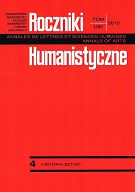Ikonografia hagiograficzna w kontekście wojen tureckich w grafice europejskiej XVI-XVIII wieku
Hagiographic Iconography Against the Background of Turkish Wars as Represented in the European Etching Graphics of the 16th to the 18th Century
Author(s): Ryszard KnapińskiSubject(s): Cultural history
Published by: Towarzystwo Naukowe KUL & Katolicki Uniwersytet Lubelski Jana Pawła II
Keywords: Hagiographic etchings; hagiographic iconography; Turkish wars against Christianity in Europe; Patron Saints; grafika hagiograficzna; ikonografia hagiograficzna; wojny tureckie przeciw chrześcijaństwu w Europie; patronat świętych
Summary/Abstract: Engravers of the post-Tridentine period recorded the most important events of their time in their etching graphics. They created these works with a view to memorialise the events, but also in order to inform the public opinion about them and to influence their thinking. Hagiographic iconography was among the most frequent graphic themes of the time, which was owing to the atmosphere of the Tridentine reforms. The Council of Trent rediscovered art as a medium for communicating the religious message. The 16th and the 18th century witnessed an excessive confrontation between the European denominations, brutal religious wars and the Turkish invasion into Christian countries. Artistic accounts of the era display a lot of martial motifs, with noticeable emphasis on the endangered status of Christianity. Catholic Church directed human thinking towards God as an Almighty Power holding the world in His hands. The etching graphics that have survived until today testify to the prevalence of this message. The role of the Divine Providence was repeatedly highlighted, as was the mediation of the Mother of God and the Saints: they implored God to spare Christianity from the religious and military turmoil. The paper draws upon a vast selection of European etching graphics to present the power of the iconographic propaganda, with a special focus on the protective and supportive role of the Patron Saints.
Journal: Roczniki Humanistyczne
- Issue Year: 58/2010
- Issue No: 04
- Page Range: 87-146
- Page Count: 60
- Language: Polish

